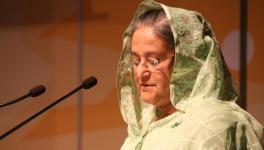Double Whammy for the Poor: First Demonetisation, Now the Budget

Tall claims, big plans, all in the speech… just not enough funds allocated to implement them!
Budget, 2017 was announced by finance Minister Arun Jaitley on the afternoon of 1st February. The budget allocations are based on an expected growth rate of 11.75% (unadjusted for inflation). Given the present state of the economy, after demonetisation, this is a highly unrealistic expectation. The budget, with its miserly allocation to almost all sectors, is going to contribute very little to the economic growth.
The finance minister mentioned in the budget speech that ‘demonetisation has reduced the demand in the economy, which needs to improve’. Given this acknowledgement of a downturn in the economy, one may have thought that budget will allocate funds for increased government spending, to push up the demand in the economy. But if we look at the figures, the actual expenditure as a proportion to GDP has actually come down from 13.4 per cent to 12.7 per cent.
On the face of it, the funds allocated by the government for the schemes and plans would obviously look higher (marginally) than the allocations last year. But, if we take inflation in to account, there is hardly any increase in total allocations. In fact, the allocation to some schemes like MGNREGA went down marginally, after adjusting for inflation.
Here are a few promises of the budget 2017
Farmers’ income to be doubled
The finance minister said that farmer’s income will be doubled by 2022. But, no allocation has been made for the same. All he talked about is providing more credit, which anyway banks are supposed to give. Farmers have faced two successive years of drought. Added to that jolt, demonetisation has hit the agriculture structure quite badly. Despite these factors, no debt relief whatsoever has been provided to the farmers.
Create more jobs
How does he plan to create jobs? Allocation for MGNREGA is 48 thousand crores. The estimate for the amount spent last year is 47.4 thousand crores. Budget allocations would actually fall when adjusted for inflation. Considering the downturn in the economy, MGNEGA allocation is not going to compensate for job losses that have occurred in the economy due to demonetisation.
Increased investment in infrastructure and development projects
Yes, Infrastructure has to improve! But, for that government needs to spend money on infrastructure creation. But, in this budget, capital expenditure as proportion to GDP has fallen from 1.86 per cent of GDP to 1.84 per cent of GDP. One wonders, how Mr. Jaitley plans to improve infrastructure without increasing capital expenditures.
Tax incentive to middle classes
Tax incentives have been provided to a small section of tax payers. The budget has given direct tax concession of 20,000 crores, to the income tax payers. However, an extra tax revenue of 75000 crores would be raised from various indirect taxes. Since, Indirect taxes are taxes on consumption, the burden of such taxes fall more on the shoulders of poorest of the population, as they spend most of their incomes on consumption. In all, this is another anti-poor move.
Health, Education & social sector
While there is a small increase in the budget towards health expenditure, the share going to school education and literacy has actually declined (as % of GDP) from 2.2 per cent in 2016-17, to 2.16 per cent in 2017-18. There is a small increase in social sector expenses. But factoring in inflation, it would barely be sufficient to meet the increase in salary due to the 7th Pay Commission!
Expenditure on Welfare of Tribals too is very low. It is 1.46 % of the total budget outlay which is far below the statutory norm. Expenditure on Welfare of Schedule Castes stands at 2.4 % of the total budget outlay which is again far below the statutory norm.
Overall, while the expenditure should have actually gone up substantially considering the implementation of 7th pay commission this year, it has actually gone down. Which means that the non-salary component of expenditure, would go down even further.
Fiscal deficit has been kept low by lowering expenditure, rather than improving revenue as a proportion of GDP. This is clearly not an expansionary budget. It is a budget with a lot of fluff and no substance. We talked to three economists, here is what they have to say about the budget.
“Depressing budget under depression – at the time of slower growth, the size of the budget is actually lower than that of last year as a proportion of GDP”, Surajit Das
“Unimaginative! Not even a vague attempt at undoing the adverse effects of demonetisation”, Vikas Rawal
“Contrary to the analysis of the dismal state of the post-demonetised economy and conditions of the people in the government's economic survey, the budget offers them no relief and in fact adds to their burden.”, Smita Gupta
Get the latest reports & analysis with people's perspective on Protests, movements & deep analytical videos, discussions of the current affairs in your Telegram app. Subscribe to NewsClick's Telegram channel & get Real-Time updates on stories, as they get published on our website.
























